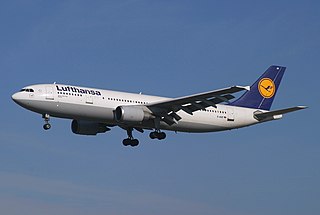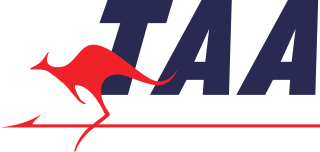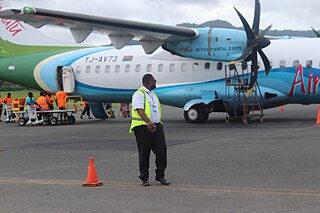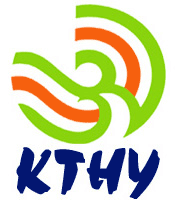
The Airbus A300 is Airbus's first production aircraft and the world's first twin-engine, double-aisle (wide-body) airliner, developed and manufactured by Airbus from 1971 to 2007.
Air New Zealand Limited is the flag carrier of New Zealand. Based in Auckland, the airline operates scheduled passenger flights to 20 domestic and 30 international destinations in 18 countries, primarily within the Pacific Rim. The airline has been a member of the Star Alliance since 1999.
Kenya Airways Ltd., more commonly known as Kenya Airways, is the flag carrier airline of Kenya. The company was founded in 1977, after the dissolution of East African Airways. Its head office is located in Embakasi, Nairobi, with its hub at Jomo Kenyatta International Airport.

The Airbus A310 is a wide-body aircraft, designed and manufactured by Airbus Industrie, then a consortium of European aerospace manufacturers. Airbus had identified a demand for an aircraft smaller than the A300, the first twin-jet wide-body. On 7 July 1978, the A310 was launched with orders from Swissair and Lufthansa. On 3 April 1982, the first prototype conducted its maiden flight, and the A310 received its type certificate on 11 March 1983.

Trans Australia Airlines (TAA), renamed Australian Airlines in 1986, was one of the two major Australian domestic airlines between its inception in 1946 and its merger with Qantas in September 1992. As a result of the "COBRA" project, the entire airline was rebranded Qantas about a year later with tickets stating in small print "Australian Airlines Limited trading as Qantas Airways Limited" until the adoption of a single Air Operator Certificate a few years later. At that point, the entire airline was officially renamed "Qantas Airways Limited" continuing the name and livery of the parent company with the only change being the change of by-line from "The Spirit of Australia" to "The Australian Airline" under the window line with the existing "Qantas" title appearing above.

Air Vanuatu is an airline with its head office in the Air Vanuatu House, Port Vila, Vanuatu. It is Vanuatu's national flag carrier, operating to Australia, New Zealand, New Caledonia and points in the South Pacific. Its main base is Bauerfield International Airport, Port Vila.

Ansett Australia was a major Australian airline group, based in Melbourne, Victoria. The airline flew domestically within Australia and from the 1990s to destinations in Asia. After operating for 65 years, the airline was placed into administration in 2001 following a financial collapse and subsequent organised liquidation in 2002, subject to deed of company arrangement. The last flight touched down on 5 March 2002.
Vietnam Airlines is the flag carrier of Vietnam. The airline was founded in 1956 and later established as a state-owned enterprise in April 1989. Vietnam Airlines is headquartered in Long Biên district, Hanoi, with hubs at Noi Bai International Airport in Hanoi and Tan Son Nhat International Airport in Ho Chi Minh City. The airline flies 117 routes across 19 countries, excluding codeshared services.
Cebu Air, Inc., operating as Cebu Pacific, is a Philippine low-cost airline based at Pasay in Metro Manila. Founded in 1988, it is Asia's first low-cost airline. It offers scheduled flights to both domestic and international destinations. The airline operates flights from five bases in Cebu, Clark, Davao, Iloilo, and its largest base in Manila.

Laker Airways was a private British airline founded by Sir Freddie Laker in 1966. It was originally a charter airline flying passengers and cargo worldwide. Its head office was located at Gatwick Airport in Crawley, England.
Air Niugini Limited is the flag carrier of Papua New Guinea, based in Air Niugini House on the site of Port Moresby International Airport, Port Moresby. It operates a domestic network from Port Moresby to 12 major airports while its subsidiary company, Link PNG, operates routes to minor airports. It also operates international services in Asia, Oceania, and Australia on a weekly basis. Its main base is Port Moresby International Airport, which is located in 7 Mile, Port Moresby, Papua New Guinea. Niugini is the Tok Pisin word for New Guinea.

Air Djibouti, also known as Red Sea Airlines, is the flag carrier of Djibouti. It first flew in 1963 and ceased all operations in 2002. In 2015, the airline was relaunched, first as a cargo airline and then, in 2016, with passenger services as well. It is headquartered in the capital, Djibouti.

Empresa Ecuatoriana de Aviación, more commonly known as simply Ecuatoriana, was the national airline of Ecuador. The carrier had an operational hiatus between September 1993 and August 1995, resuming operations on 23 June 1996, after VASP became the controlling shareholder. The airline folded permanently in 2006.

Somali Airlines was the flag carrier of Somalia. Established in 1964, it offered flights to both domestic and international destinations. It operated Boeing 720Bs, Boeing 707-300s and Airbus A310-300s on a network to the Middle East and Europe. The airline discontinued operations after the start of the civil war in the early 1990s, when the country fell into anarchy. A reconstituted Somali government later began preparations in 2012 for an expected relaunch of the carrier, with the first new Somali Airlines aircraft scheduled for delivery by the end of December 2013.

East-West Airlines was an Australian regional airline founded in Tamworth, New South Wales in 1947. It operated to major regional city-centres and connected these centres to various state capitals, and by the 1980s it was Australia's third largest domestic airline. It also carried out its own heavy maintenance in Tamworth and operated a network of Travel Centres.

MacRobertson Miller Airlines (MMA) was a Western Australian airline that operated between 1927 and 1993. After being purchased by Ansett Transport Industries in 1968, it was eventually rebranded Ansett WA.

Cyprus Turkish Airlines Limited was a Turkish Cypriot airline that served as the flag carrier for Northern Cyprus. Until its collapse in June 2010, Cyprus Turkish Airlines was the primary airline flying passengers to Northern Cyprus.
Air Afrique was a Pan-African airline, that was mainly owned by many West African countries for most of its history. It was established as the official transnational carrier for francophone West and Central Africa, because many of these countries did not have the capability to create and maintain a national airline, and had its headquarters in Abidjan, Ivory Coast. The carrier was a member of the International Air Transport Association (IATA) as well as the French Union's smaller IATA-like ATAF.

Nigeria Airways Ltd., more commonly known as Nigeria Airways, was a Nigerian airline. The company was founded in 1958 after the dissolution of West African Airways Corporation (WAAC). It held the name West African Airways Corporation Nigeria until 1971, when it was rebranded to the name it had until it ceased operations in 2003. The government of Nigeria owned a majority of the airline (51%) until 1961, when it boosted its shareholding in the company to 100% and made it the country's flag carrier. At the time of dissolution, the airline's headquarters were at Airways House in Abuja. Operations were concentrated at Murtala Muhammed International Airport and served both domestic and international destinations mainly concentrated in West Africa; the network also had points in Europe, North America and Saudi Arabia. The airline was managed by a number of foreign companies, including British Airways, KLM and South African Airways.
The Two Airlines Policy was a policy of the Government of Australia from the late 1940s to the 1990s. Under the policy, only two airlines were allowed to operate flights between state capital cities and between capitals and nominated regional centres. The Two Airlines Policy was a legal barrier to new entrants to the Australian aviation market. It restricted intercapital services to the two major domestic carriers. This anti-competitive arrangement ensured that they carried approximately the same number of passengers, charged the same fares and had similar fleet sizes and equipment.













